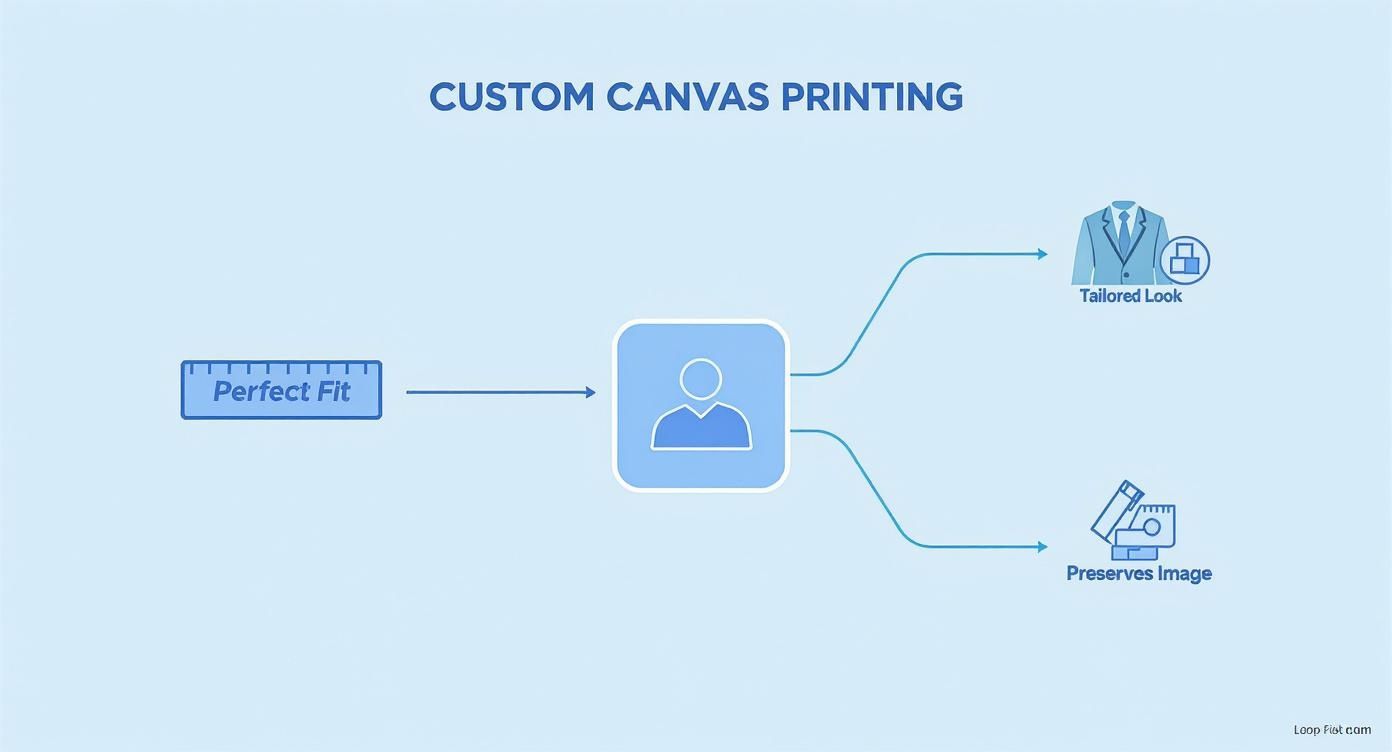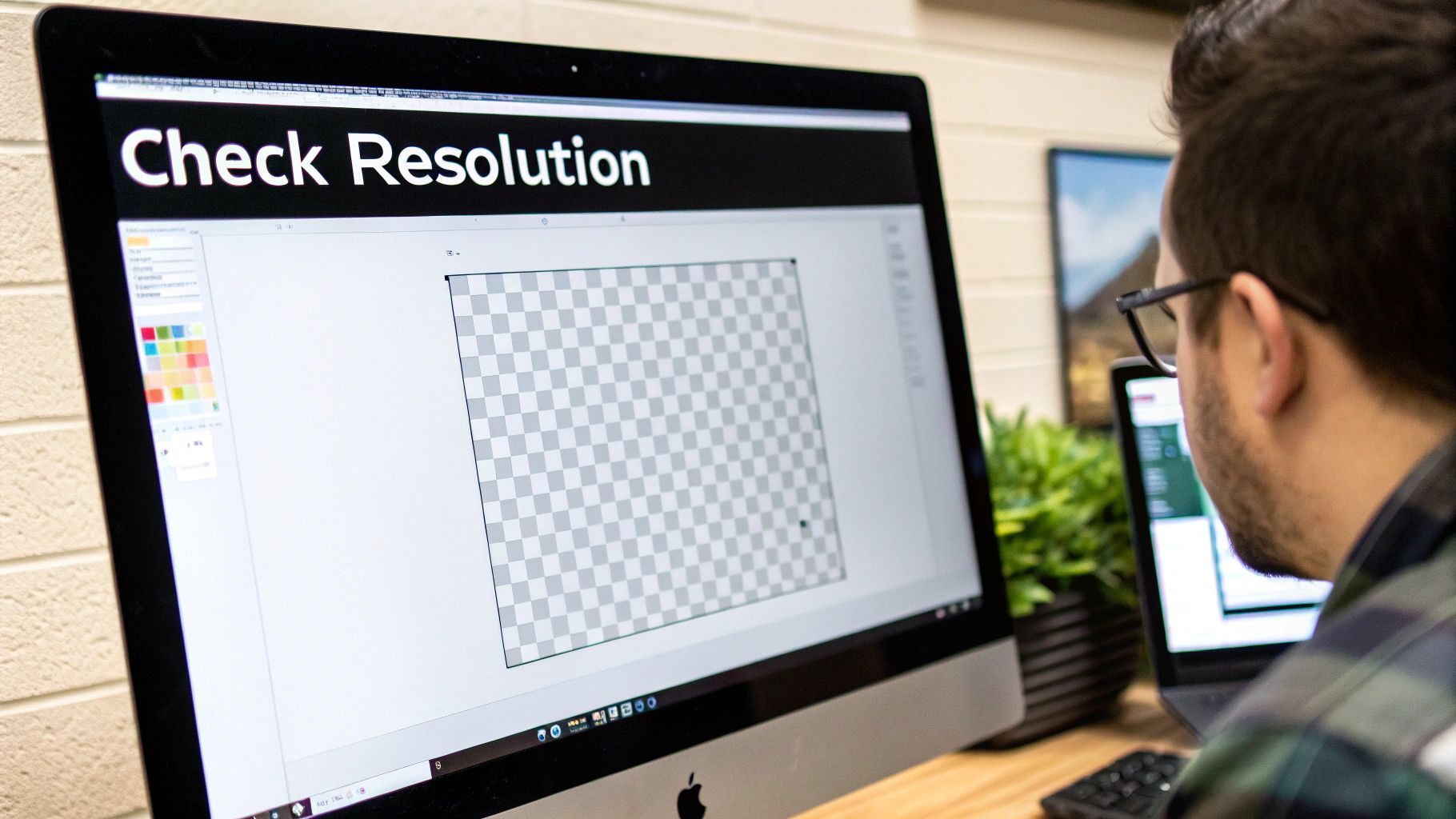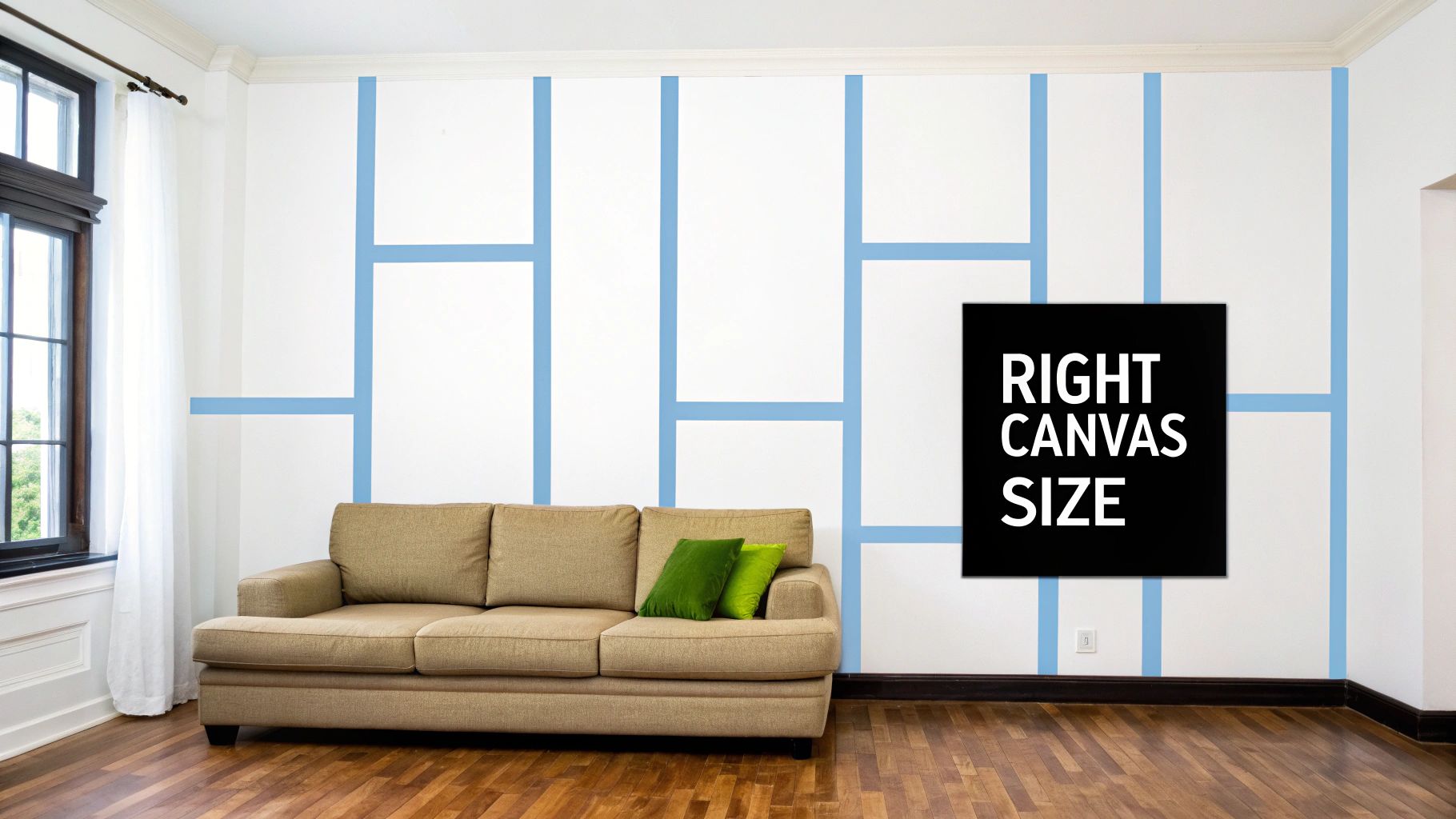
A Friendly Guide to Custom Canvas Sizes
Share
Sometimes, a standard-sized canvas just doesn't do a photo justice. We've all been there—you have a stunning picture you’re dying to hang, but the standard 8x10 or 16x20 dimensions would mean cropping out something important.
This is where custom canvas sizes come in. Think of it like the difference between buying a suit off the rack and getting one tailor-made; the custom fit just feels right and looks infinitely better. You get to create a piece of wall art that’s perfectly suited to your image and your space.
Finding Your Perfect Fit in Custom Canvases
That feeling of finding the perfect photo, only to realize it won't fit a standard frame without an awkward crop? It's a common frustration, and it’s exactly why so many people are now choosing custom canvas prints to bring their memories to life without compromise. A custom approach makes your art feel intentional, not forced into a box it was never meant for.
The desire for personalized decor is booming. The printed canvas wrap market, once valued at USD 1.2 billion, is on track to hit an estimated USD 2.5 billion. This isn't just a random trend; it shows a real shift in what we want for our homes. We're moving away from generic, mass-produced decor and toward pieces that tell our own unique stories.
Going custom gives you total creative freedom. You can finally print that breathtaking panoramic shot from your last vacation or that uniquely framed portrait without losing the heart of the moment.
To help you get started, we're going to walk through a few key ideas:
- Aspect Ratio: This is all about matching the canvas shape to your photo's natural dimensions.
- Image Resolution: We’ll cover how to make sure your print comes out crisp and clear, no matter how big you go.
- Spatial Harmony: You'll get some practical tips for picking a size that feels right in your room.
By the time you're done, you'll feel ready to create your own canvas print that looks like it was made just for your home—because it was! Let's find the perfect fit for your vision.
Why Aspect Ratio Is Your Best Friend
Alright, let's talk about aspect ratio. Forget the complicated math for a second. In simple terms, it's just your photo's natural shape—the relationship between how wide it is and how tall it is. Nailing this is the secret sauce to getting a custom canvas print that looks exactly like the picture in your head.
Think about it this way: you have a gorgeous, wide panoramic shot of a sunset over the ocean. Now, imagine trying to cram that long, rectangular image onto a perfectly square canvas. It's a disaster, right? You'd either have to chop off the beautiful colors on the sides or squash the whole thing, turning the sun into a weird-looking oval.
This is exactly why getting a handle on aspect ratio is so critical when you’re looking at custom canvas sizes. It’s all about making sure the canvas shape respects the original composition of your photo.
Matching Your Photo Shape To The Canvas
Not all photos are created equal. Different cameras and phones capture images in different default shapes. For instance, a photo from a typical DSLR camera usually has a 3:2 aspect ratio, which gives it that classic rectangular feel. Your iPhone, on the other hand, likely shoots in 4:3, and that perfect Instagram shot is a 1:1 square.
Each of these ratios has its own vibe. If you try to force a rectangular 3:2 photo onto a 1:1 square canvas, you’re going to lose a huge chunk of the image off the sides. This is where a custom size becomes your hero—it lets you create a canvas that perfectly mirrors your photo’s native shape, preserving every last pixel you wanted to capture.
This infographic shows just how a custom size lets you get that perfect fit without sacrificing any part of your original image.

As you can see, the real win is that your photo stays completely intact. It just fits perfectly into a canvas that was practically made for it, with zero awkward cropping.
Practical Tips for Aspect Ratio Success
You really don't need to be a math genius to get this right. The trick is to just look at your photo's shape. Is it long and skinny? A perfect square? A traditional rectangle?
Key Takeaway: Before you hit "order," just look at your image and ask yourself, "What shape is this?" Choosing a canvas that mirrors that shape is the single best thing you can do to guarantee a flawless result.
So, if you're printing a square photo, you’ll naturally want a square canvas like a 12x12 or 20x20. If you’re thinking about bringing some social media memories to life, our guide on printing photos from Instagram has some great tips for handling those unique dimensions.
By simply paying attention to your photo’s original shape, you can pick a custom canvas size that works with your image, not against it. It's a small step that makes a huge difference, elevating your print from just "good" to truly spectacular.
Matching Image Resolution to Canvas Size
Have you ever been excited to receive a large canvas print, only to find it looks fuzzy and pixelated? It’s a common letdown, and it all comes down to image resolution.
Think of your photo as a mosaic made of tiny, colorful tiles called pixels. To create a large, sharp image, you need a massive number of these tiles. If you don't have enough, the printer has to stretch each tile to fill the space, making the final picture look blurry and unprofessional.
This is why getting the relationship between your photo's pixel count and your chosen canvas size right is so crucial. A great print starts with a great file.

The magic number we're aiming for is a high DPI, which stands for Dots Per Inch. It’s the standard measure for print quality. For a canvas that looks sharp and clear from a normal viewing distance, you’ll want a resolution of at least 150 DPI.
Minimum Image Resolution for Common Canvas Sizes
To make things simple, here’s a quick reference chart. Use it to check if your photo has enough pixels to produce a stunning, high-quality print at your desired canvas size. The resolutions here are based on an ideal printing quality of 150-300 DPI.
| Canvas Size (Inches) | Minimum Required Resolution (Pixels) | Recommended Megapixels (MP) |
|---|---|---|
| 8" x 10" | 1200 x 1500 px | 2 MP |
| 16" x 20" | 2400 x 3000 px | 8 MP |
| 24" x 36" | 3600 x 5400 px | 20 MP |
| 30" x 40" | 4500 x 6000 px | 27 MP |
Checking your image's pixel dimensions is easy to do on your computer or phone before you upload. This one quick step can save you from the disappointment of a blurry print. You can find more in-depth tips to get your file ready in our guide on https://everone.shop/blogs/news/how-to-print-photos-on-canvas.
Pro Tip: If you're ever unsure, always go with the highest-resolution file you have. It's easy to shrink a large, detailed image without losing quality, but it's nearly impossible to make a small, low-resolution image look good when blown up.
Start With a High-Quality Source Image
At the end of the day, your final canvas print can only be as good as the original photo you provide.
If you’re starting with a professional photo or a picture from a modern smartphone, you’re probably in good shape. The real trouble comes from images saved from social media or text messages. These are almost always compressed to save space, which means they’ve lost a ton of pixel data and aren’t suitable for printing, especially on a large canvas.
The global artist canvas market, which was valued at USD 3.36 billion and is expected to grow to USD 5 billion, is powered by digital printing. Modern printers are incredibly precise, but they can't invent detail that isn't there in the source file. To ensure you’re using legal, high-quality visuals that meet these resolution demands, you can explore the top sources for high-quality, royalty-free images.
Simply put, starting with a great photo is the best way to guarantee a fantastic result.
Choosing the Right Canvas Size for Your Space
Alright, you’ve got the technical details down. Now for the fun part: picking a canvas size that actually brings your room to life. Getting the dimensions right can elevate a simple print into a show-stopping focal point. But get it wrong, and your decor can feel... well, a bit off.
Imagine hanging a tiny postcard on a massive, empty wall. It just gets lost, right? The key is to find a size that feels intentional. A great piece of wall art doesn't just fill a void; it enhances the entire room, creating a sense of balance that just feels right.
The Two-Thirds Guideline for Perfect Placement
Here's a little trick straight from the interior design playbook: the two-thirds guideline. It’s super simple. When you're hanging a canvas over furniture—like your sofa, bed, or a console table—aim for a piece that's about two-thirds the width of whatever it's hanging above.
So, if your couch is 90 inches wide, you'd look for a canvas (or a group of them) that fills up about 60 inches of that space. This simple ratio creates a beautiful visual connection between your furniture and your art, making the whole setup look polished and cohesive.

Pro Tip: Not sure if a size will work? Grab some painter's tape and mark out the dimensions on your wall. Seriously, this is a game-changer. Live with the outline for a day or two. You'll know almost immediately if it’s overwhelming, underwhelming, or absolutely perfect.
This hands-on approach removes all the guesswork and gives you the confidence that you'll love the final result.
From Single Statements to Gallery Walls
The size you choose also helps tell a story. Are you going for one dramatic, "wow" moment, or are you looking to create an intimate collection that draws people in?
Let's break down a few popular ways to go:
- The Oversized Statement: Nothing makes an impact like a single, massive canvas. This is your go-to for rooms with high ceilings or for that big, blank wall you’ve been staring at. Think of a stunning landscape over the fireplace or a bold abstract piece that anchors a minimalist living room.
- The Classic Trio: A set of three canvases, all the same size and hung in a neat row, delivers a clean, modern vibe. It’s a fantastic way to display a panoramic photo or split a single image into three dynamic parts for a bit of artistic flair.
- The Eclectic Gallery Wall: This is where you can really let your personality shine. Mix and match different sizes, shapes, and even frame styles to build a wall that's uniquely you. It’s perfect for telling a story with family photos, travel adventures, or your favorite art finds. Want some more inspiration? Check out our guide to https://everone.shop/blogs/news/unique-wall-art-ideas.
These ideas about scale and balance don't just stop at canvas prints. The same principles apply when you're selecting peel and stick wallpaper for your home, helping you create a space that feels completely put-together.
Common Mistakes to Avoid with Custom Canvases
Ordering a custom canvas should be exciting, but a few common slip-ups can easily turn that excitement into frustration. The good news? They're all completely avoidable with a little bit of prep work.
The number one mistake we see is people ignoring their photo's aspect ratio. This is how you end up with awkward, forced crops that cut off important details from the edges of your image. Another big one is using a low-resolution photo for a large canvas, which almost always leads to a blurry, pixelated print.
A custom canvas should capture your vision perfectly. By avoiding these common errors, you ensure the final product is something you'll be proud to display for years to come.
Finally, it’s easy to misjudge the scale of the canvas for your wall. What looks right on screen can end up looking tiny and lost—or overwhelmingly large—in your actual space. A little planning makes all the difference.
A Quick Checklist for Flawless Prints
Think of this as your pre-flight checklist before hitting that "order" button. Taking a few moments to run through these points can save you from a world of disappointment later.
- Check Your Aspect Ratio: Does the canvas shape actually match your photo's shape? If you have a long panoramic shot, trying to squeeze it onto a square canvas just won't work without some serious cropping.
- Verify Image Resolution: Double-check our resolution chart to make sure your image has enough pixels for the print size you want. Always, always upload the original, highest-quality file you have.
- Measure Your Space: This is a game-changer. Grab some painter's tape and physically outline the canvas dimensions on your wall. It's the best way to visualize how the final piece will fit and feel in your room.
More and more people are looking for personalized art, and the stretched canvas market is expected to hit USD 2.3 billion because of it. This trend is even being fueled by school policies that encourage arts and crafts. To learn more, check out the full stretched canvas market research. By following these simple tips, you can make sure your piece is a beautiful part of that movement.
Got Questions About Custom Canvas Sizes? We’ve Got Answers.
Choosing the perfect custom canvas should be the fun part, not a source of stress. To make sure you feel totally confident hitting that "order" button, we've tackled some of the most common questions that pop up.
What’s a Gallery Wrap, Anyway?
You’ve probably seen them everywhere. A gallery wrap is a super popular, modern way to finish a canvas print. Instead of putting it in a traditional frame, the canvas itself is stretched around a sturdy wooden frame, with the image continuing right over the edges.
The result is a clean, three-dimensional piece of art that looks fantastic right out of the box—no extra framing needed. We typically use a 1.5-inch deep frame, which gives the canvas a really substantial, professional presence on your wall.
How Do I Pick the Right Finish?
The finish is the final touch that can really change the whole vibe of your print. It all comes down to personal taste and where you plan to hang it.
Here’s a quick breakdown:
- Matte Finish: This is your go-to for a classic, fine-art look. Because it has no reflection, it’s perfect for rooms with lots of bright light, as you won't get any annoying glare. It gives images a soft, almost velvety texture that’s great for portraits and subtle landscapes.
- Glossy Finish: Want your colors to scream? Go glossy. This finish adds a vibrant, high-impact punch, making colors look richer and deeper. It’s a fantastic choice for bold, modern photos or any image where you want the colors to be the star of the show.
Think about the lighting in your room. A matte finish is incredibly forgiving and looks great from any angle. A glossy finish can be a real showstopper, but it’ll catch the light, so be mindful of placing it directly across from a window.
Can I Go Bigger Than My Photo’s Resolution?
Technically, yes, but you really, really shouldn't. Pushing an image beyond what its resolution can handle is a recipe for a blurry, pixelated mess. All those crisp little details in your photo will get stretched out and distorted.
Trust us on this one. It's always better to stick to the recommended print sizes for your photo's resolution. That's the secret to getting a canvas print that's sharp, clear, and looks absolutely stunning on your wall.
Ready to bring your favorite photo to life? At everone prints, we help you create gorgeous, high-quality custom art that you'll cherish for years. Start designing your perfect canvas today!
